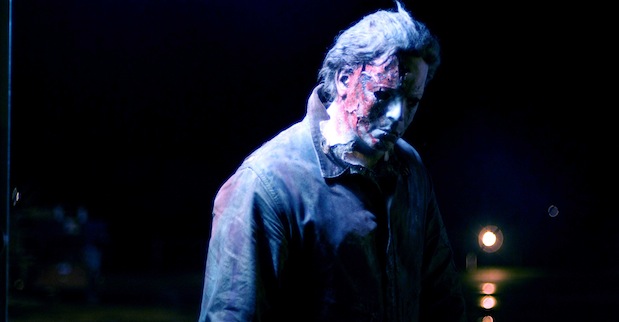
Written by UTG critic Grace Duffy, Scene & Heard takes a look at the music that makes our favorite films so memorable. Whether it’s the 400-piece orchestra Christopher Nolan used for The Dark Knight, or the dozen or so bands that contributed to the soundtrack of Top Gun, there is no denying the impact music has on movies and this column hopes to highlight the best of the best.
If you have a suggestion for a film we should cover on Scene & Heard, please contact us by emailing utgjames@gmail.com.
Twas the night before All Hallows Eve, and not a soul was stirring. Through the frosted window the darkness is creeping. A shock, a scream, a crescendo! OK, I’m feeling a little poetic given the night that’s in it. But even so, I love Halloween. And it feels markedly like an anticlimax for me this year as my sister has merrily abandoned me for her boyfriend instead of our annual DVD-in. I’m appalled, but have decided to devote this week’s Scene and Heard to some classic and not-so-classic Halloween movies and their equally chilling soundtracks as recompense.
It’s an old saying, but one that lingers true – a great horror film is often based more on a score than it is on screams. Films like The Haunting (in its original, 1963 incarnation) and Psycho earned much of their darkness and edge from the eerie musical accompaniments that drifted like ghosts in the background. Even something as mainstream as Jaws would lack a certain element of suspense and danger without its terse, unsettling theme. A great horror film needs a number of elements to succeed, but in this genre more so than others a well-judged musical score can so often provide the atmosphere and foreboding to really suck an audience in.
Take for example John Carpenter’s masterful Halloween – which was actually on TV last night, and which I decided was too creepy for me to look at alone. I have to be one of the only people I know who was better able to watch something scary when I was six or seven, but my nerves have eroded as I’ve gotten older. Halloween is a relatively simple story of one inexplicably deranged man intent on murdering an innocent teenager, but its inherent darkness and unsettling nature is enhanced greatly by the insidious theme that accompanies it. The delicate piano refrain is ghostly and unnerving just as it is, but when allied with Michael’s ghoulish mask and imposing frame it pierces you right to your core. One of the creepiest things about Michael Meyers, in my humble opinion, is how long he takes to follow through on his bloody intentions. He stalks his victims for several days beforehand, rendering them anxious and uneasy before ever a knife is drawn, and has his would-be victim Laurie’s babysitting charges branding him the “bogey man.” What’s more, after his initial assault on Laurie in a house across the street from where she’s minding the children, he follows her as she flees frantically back and pounds on the door to be let inside. He ambles painfully slowly towards her as the music pours in the background, giving us just enough time to picture the terrible consequences of being caught. The theme is a master class in underpinning terror – it’s a light and airy piano thrill that seems affected and distracted, hinting at something awful just on the fringes of your sight. It’s backed up by a troubling and oppressive electronic wave and a subtle percussive beat. If the piano is the character’s instinct that something is not right, the electronics represent the blind and overpowering panic that sets in when Meyers reveals himself. It’s incredibly basic and even serene as a soundtrack piece, but this one simple piece of music endows the film with so much of its horror.
The Exorcist has lost something of its ability to provoke and frighten over the years (imagine what those disturbed by a child using the c-word would say about Kick Ass) and it may not quite make people faint in the aisles any more, but its music is peril incarnate. The theme “Tubular Bells” by Mike Oldfield plays eerily in the darkness as Father Merrin, at this point an unnamed and mysterious figure, steps warily out of a taxi in the ghostly glare of a streetlight. He looks up at the house before going through the gate – the sight of this unknown figure entering a domain of despair, harried by the ethereal peeling of the bells is an iconic moment in cinema. The burden of his task seems as overwhelming as the stark grey structure in front of him, and the music shivers accordingly.
However, for all that the above classics are essentials in any fright fest, my one steadfast Halloween tradition where movies are concerned is Hocus Pocus. I’ve been religiously watching this film every All Hallows Eve since I was very small and it, too, comes equipped with a harrowingly beautiful musical accompaniment. Inauspicious intentions notwithstanding, Sarah’s “Come Little Children” theme is divine. It’s an ethereal, bewitching, luminous little delight that perfectly encapsulates the magic of a Disney theme with the otherworldliness of a Halloween score. Though the film is obviously not intended to be scary in any way, there is just the right amount of spectral eloquence to the song to make the hairs on your neck stand on end.
I’m now off to watch Paranormal Activity, and with all of these ominous pieces lilting through my head already the end result mightn’t be very pretty. Happy Halloween to all!
By Grace Duffy
- MUSIC VIDEO: Tear Out The Heart Ft. Dan Marsala (Story Of The Year) – “Coffin Eyes” - August 5, 2013
- Sleeping With Sirens Announce The Feel This Tour - August 5, 2013
- MIXTAPE: Curren$y & Jet Life – ‘Red Eye’ - August 3, 2013

